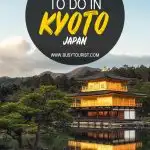If a trip to Japan conjures images of magnificent temples, cherry blossoms, and old wooden buildings, then Kyoto is the place to visit.
Kyoto is home to 1.4 million people, making it the seventh largest city in Japan.
Kyoto was once the capital of Japan, which is why you will find such an incredible number of temples and shrines here.
Kyoto was also spared the devastation which occurred during the bombings of World War II, meaning it has been very well preserved.
While Kyoto is a modern city, you won’t have to look very hard to find historic districts that give visitors a taste of life in old-world Japan.
This is one of the reasons millions of tourists every year visit Kyoto in growing numbers.
Kyoto is home to over 1600 temples, many with beautiful Zen gardens and massive gates. There are also more than 400 Shinto shrines.
However, there are many more things to do in Kyoto, Japan than simply visiting temples and shrines.
In Kyoto, there are plenty of opportunities to immerse yourself in traditional Japanese culture as well as experience the natural wonder that can still be found in the city.
While it’s easy to become overwhelmed at the prospect of exploring a new city like Kyoto, here a few things to get you started on what to do in Kyoto.
1. Nanzenji Temple
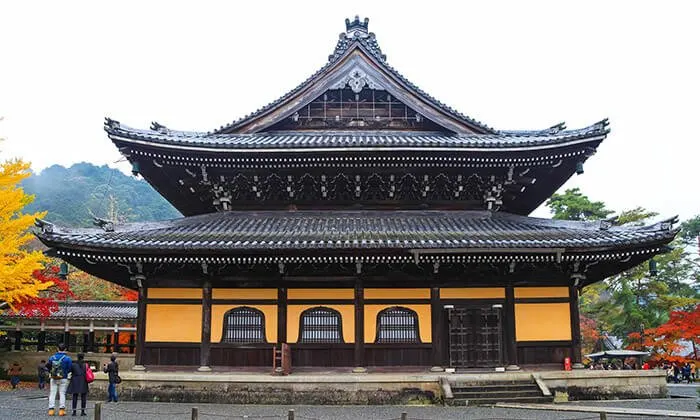
Nanzenji Temple
Nanzenji Temple is one of the most popular Zen temples in Kyoto and all of Japan and is famous for its massive entrance.
It was constructed as the retirement palace for Emperor Kameyama in 1386.
According to the legend, it was plagued by a poltergeist until a Zen priest banished the spirit through meditation.
Since then it has functioned as a Zen temple, and to this day one can partake in Zazen meditation classes here.
On the balcony, visitors will encounter an incredible view of Kyoto.
Another point of interest is the Roman style aqueduct dating back to the Meiji Era, which is still considered an engineering triumph.
Address: Nanzenji Fukuchicho, Sakyo Ward, Kyoto, 606-8435, Japan
2. Shoren-in Temple
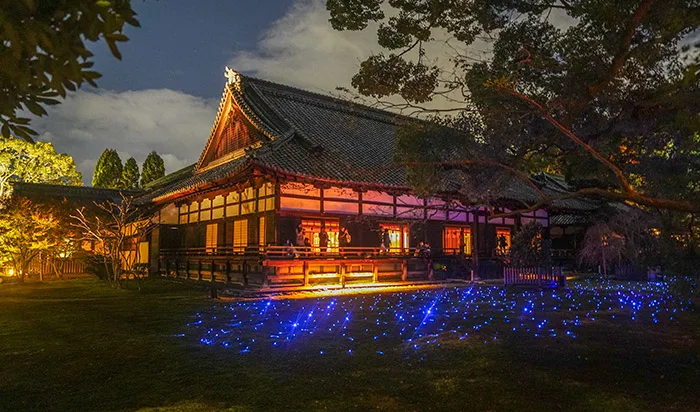
Shoren-in Temple
This was created as a Monzeki temple, where a member of the imperial family was traditionally the head priest.
It was built in the late 13th century and was used as an imperial palace after the Great Kyoto Fire of 1788.
Wooden walkways connect the temple’s buildings. The Kachoden drawing room is the first stop for visitors, with a selection of paintings and portraits on the walls and sliding doors.
The Shijokodo Hall is the main room of worship, and many rare objects can be seen here.
Venturing outside, visitors will get to enjoy winding paths through the temples’ beautiful gardens. Observatories offer views of the city.
During the fall and spring, visitors can also enjoy an evening garden tour, highlighted by dramatic lighting.
Address: 69-1 Awadaguchi Sanjobocho, Higashiyama Ward, Kyoto, 605-0035, Japan
3. Kinkakuji Temple
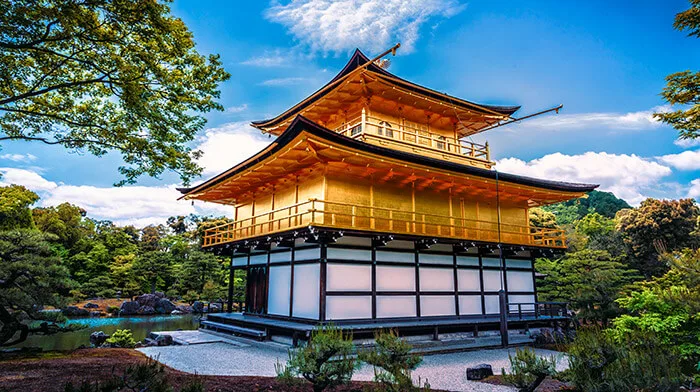
Kinkakuji Temple
In Northern Kyoto, you’ll find the Zen temple known as Kinkakuji Temple. “Kinkakuji” translates to Temple of the Golden Pavilion.
Its most striking feature is the fact that it is covered with gold leaf, making this one of the most popular tourist destinations in Kyoto.
This structure was originally a retirement villa for a Rinzai shogun Ashikaga Yoshimitsu. Throughout its history, it was burned down several times.
The structure as it stands now was reconstructed in 1955.
If you’re interested in architecture, this is an essential stop on your visit to Kyoto, Japan.
Each of the three floors of the temple boasts its own architectural style. The first floor was created in the classic Shinden-zukuri style, with white plaster and wood.
The samurai used to reside on the second floor, which was created in the Bukke style.
Finally, the third floor is similar to a traditional Chinese Zen Hall. With numerous statues and a garden leading to a teahouse, visitors will have a lot to take in.
As this is one of the most popular things to do in Kyoto, Japan, come early to beat the crowds!
Address: 1 Kinkakujicho, Kita Ward, Kyoto, 603-8361, Japan
4. Ishibei-koji Alley
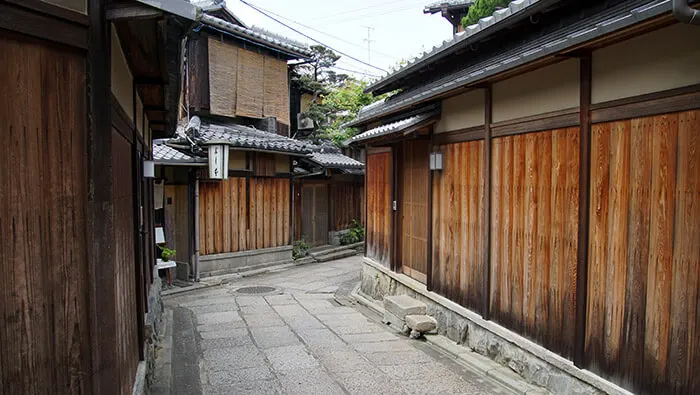
Ishibei-koji Alley
Visting Ishibei Alley is like taking a trip into the past. If you’re looking for things to do in Kyoto, to give you a taste of the old world, this narrow street is the perfect destination.
Located close to the Kyoto Station, you’ll find traditional architecture, with restaurants, tea houses, and saloons which all work towards preserving the feel.
While many other areas in the city continue to be built up and modernized, the local government has made a special effort to preserve Ishibei Alley so its traditional charms can continue to be appreciated by visitors.
Address: 463-29 Shimokawaracho, Higashiyama Ward, Kyoto, 605-0825, Japan
5. Shimogamo-jinja Shrine
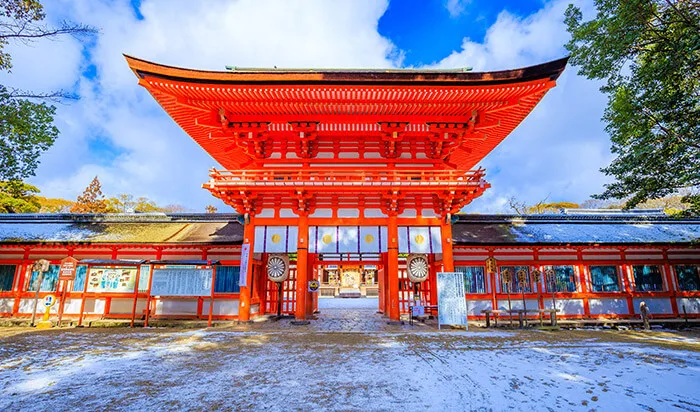
Shimogamo-jinja Shrine
The Shimogamo Shrine is a UNESCO world heritage site located where the Takano and Kamo rivers converge.
It is one of Japan’s oldest Shinto shrines, dating back to 794 before Kyoto was established as Japan’s capital.
It is also one of the seventeen Historic Monuments of Ancient Kyoto.
This site is located in the Tadasu no Mori, a large forest whose trees are up to 600 years old thanks to preservation efforts.
The shrine is also host to a number of festivals throughout the year, such as the Aoi Matsuri in May.
Address: 59 Shimogamo Izumikawacho, Sakyo Ward, Kyoto, 606-0807, Japan
6. Fushimi Inari Taisha Shrine
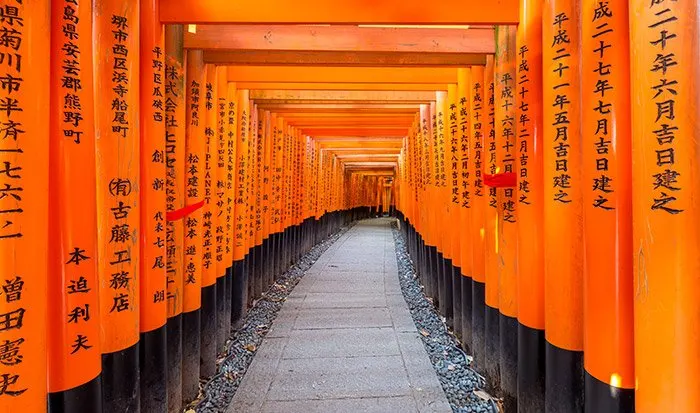
Fushimi Inari Taisha Shrine
In southern Kyoto you’ll find Fushimi Inari Taisha Shrine. Inari is the Shinto god of rice, harvest and business. This is a popular spot for photo-ops and for good reason.
This shrine is based at the bottom of a mountain and contains a stunning network of vermilion torii gates.
Visitors will ascend Mt. Inari, which is 233 meters while passing through different shrine buildings on the way.
This is a 2-3 hour hike, and you’ll even find restaurants offering traditional dishes on the way.
Starting in the Edo period, it was customary to offer a donation of torii to be granted a wish or give thanks for one which had been granted, and Japanese businesses have donated the torii you’ll see at Fushimi Inari Taisha Shrine.
This site is visited by several million worshippers when it comes time for Japanese New Year.
Address: 68 Fukakusa Yabunouchicho, Fushimi Ward, Kyoto, 612-0882, Japan
7. Gekikara Shotengai
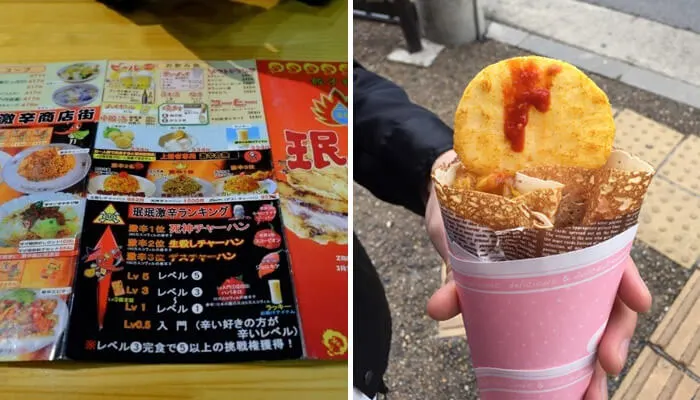
The Kyoto Project
Are you interested in spicy food? If so, you’ll be pleased to discover that there’s a whole street in Kyoto dedicated to it.
It is called Gekikara Shotengai, which roughly translates to ‘Intense Spice Shopping Street’ and is located in west Kyoto.
Traditional Japanese cuisine isn’t typically spicy, but these kinds of dishes are becoming increasingly popular in Japan.
Local residents of Muko town were looking for a way to stand out and offer something special to bring in new business.
This is how Gekikara Shotengai was born.
Here you will find spicy tasty treats that can’t be found anywhere else, such as habanero ice cream and crepes known as “Sudden Death Dogs,” available in levels from 1 to 5 with 5 being the spiciest.
Address: Kotsukuda-19 Teradochō, Muko, Kyoto 617-0002, Japan
8. Kurama-dera Temple
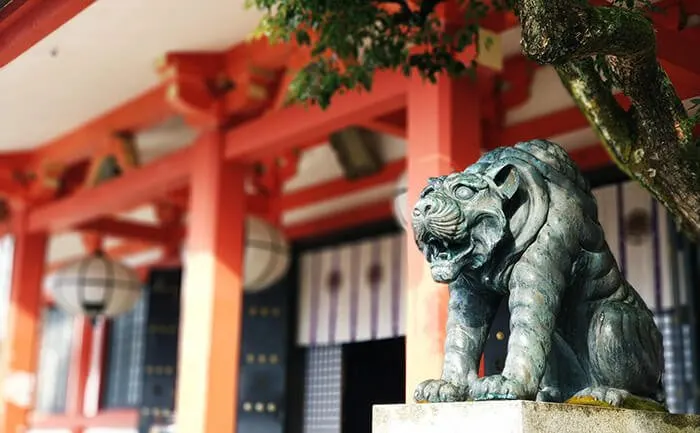
Kurama-dera Temple
About one mile from Kyoto’s city center you will find Kuramadera Temple, which is located in a rural area known for its hot springs.
Between Kurama and Kibune you’ll find a serene hiking trail that offers stunning vistas for those who make the journey.
As you make your way to the temple along the 30-45 minute steep wooded climb, you will come across a shrine known as Yuki Jinja, which is famous for the annual fire festival.
You can also ride a cable car up the mountainside if you want to take in the scenery from the air. At nearby Kurama Onsen, visitors can enjoy outdoor and indoor baths.
Address: 1074番地 Kuramahonmachi, Sakyo Ward, Kyoto, 601-1111, Japan
9. Maruyama Park
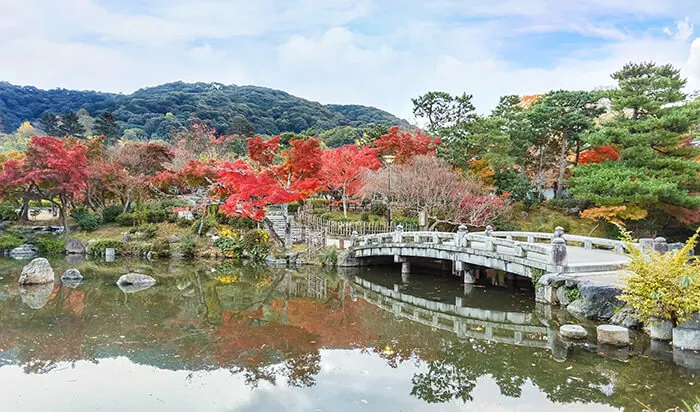
Maruyama Park
A 20-minute bus ride from Kyoto station, Maruyama Park is one of the oldest parks, and is one of the best places to visit to view the cherry blossoms in the spring.
As a result, the park can end up pretty overrun with tourists when the blossoms peak in April, so get there early.
Visitors enter the park through Yasaka Shrine, which is located in the Gion District.
This park is so spectacular that the government has designated it as an official Place of Scenic Beauty.
Despite the crowds you’ll encounter during the festivals, it is well worth it to visit during the hanami, or cherry blossom viewing parties.
At the center of the park, you’ll find a weeping cherry tree, or shidarezakura, which is breathtakingly illuminated at night.
Address: 463 Maruyamacho, Higashiyama Ward, Kyoto, 605-0071, Japan
10. Arashiyama
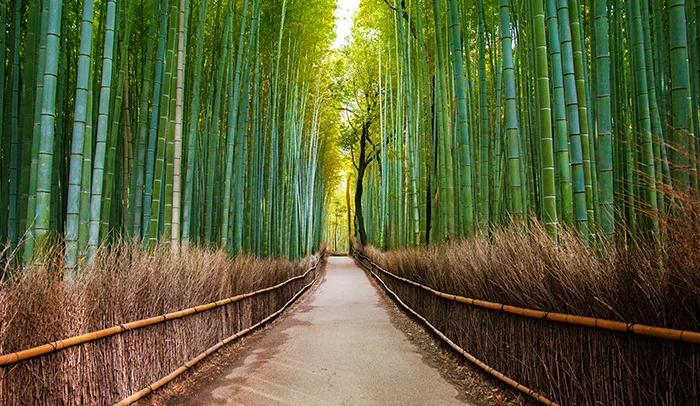
Arashiyama
No visit to Kyoto is complete without a visit to Arashiyama, located in the far west area of Kyoto.
While there are various temples and shrines in this sight-seeing district, the real star of the show is the Arashiyama Bamboo Grove.
With rising bamboo stalks, this has also been designated as a Historic Site and Place of Scenic Beauty.
Boats are available for rent and this makes a great way to explore this beautiful area.
Also in Arashiyama, you’ll find the Katsura Rikyu Imperial Villa. This is a perfect example of classic Japanese architecture, as well as garden design.
Keep in mind you will need to apply for a visit, however.
If you want to take some time out to appreciate Japan’s natural beauty, Arashiyama needs to be high on your list of things to do in Kyoto.
11. Fushimi Sake District
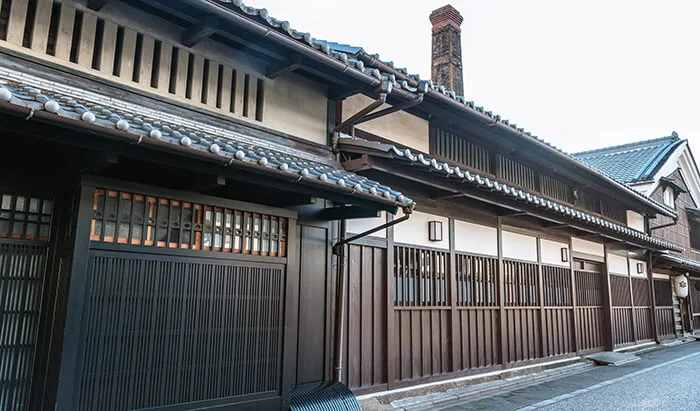
Fushimi Sake District
Few things say Japan like sake. Along the Horikawa River in southern Kyoto, you’ll find the Fushimi Sake District.
Nearly 40 sake breweries claim this area as their home, including Gekkeikan, which was founded in 1637.
A rice wine, sake is a traditional Japanese drink that dates back to at least the 8th century.
Whether you happen to be a connoisseur or you’ve never tried it, this is a perfect chance to sample some authentic sake.
Many of the bulidings in the area still maintain their traditional appearance, making the experience all the more enjoyable.
At Gekkeikan Okura you can learn about how sake is made and as well as taste some of their world-renowned offerings.
There are numerous temples in the nearby area, such as the Fushimi Inari Shrine and Choken-ji Temple, making it easy to fit into a day of sightseeing.
Address (Gekkeikan Okura): 247 Minamihamacho, Fushimi Ward, Kyoto, 612-8043, Japan
12. Jikkokubune Canal Cruise
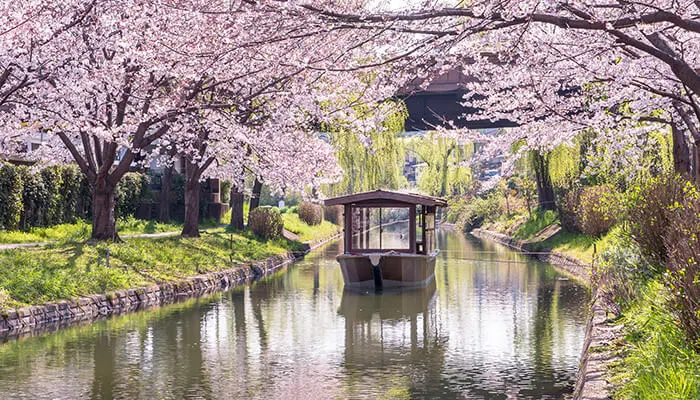
Jikkokubune Canal Cruise
If you’re visiting Kyoto’s Fushimi Sake District, don’t miss the opportunity to enjoy the area by boat.
Jikkokubune boats run from spring to autumn and are a great way to take in the natural beauty and the brewery district.
During the Edo period, these flat-bottomed boats ran between the Fushimi and Osaka and continue to transport tourists to this day.
After walking around the district and sampling different sakes, a boat trip is the perfect choice.
Whether you’re taking in the cherry blossoms or the autumn leaves, a Jikkokubune canal cruise is an unforgettable way to experience Kyoto.
Address: 680-1 Motozaimokucho, Fushimi Ward, Kyoto, 612-8043, Japan
13. Japanese Tea Ceremony
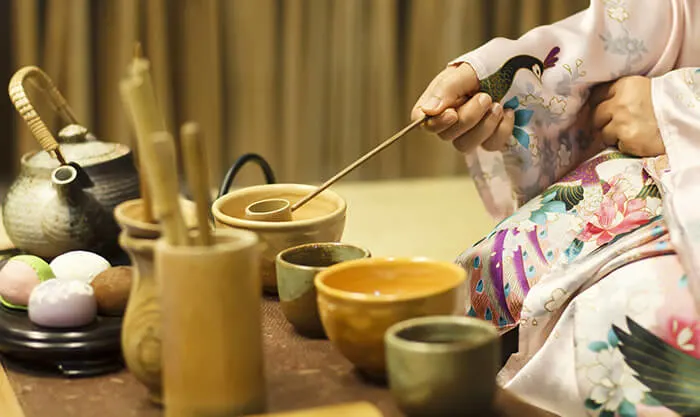
Japanese Tea Ceremony
If you’re not sure what to do in Kyoto and have an interest in traditional culture, take part in an authentic Japanese tea ceremony.
Whereas we may treat tea as an everyday occurrence, traditional Japanese culture and Zen Buddhism places great importance on this seemingly simple act.
For the best possible experience, be sure to visit a tea ceremony at Ju-An, a tea-house located inside Jotoku-ji Temple.
The tradition of the tea ceremony dates back hundreds of years and is full of symbolism and spirituality.
You may never look at the act of drinking tea the same way again after visiting Kyoto!
Address: Tominokoji Dori, 556, Gojo-sagaru, Shimogyo Ward, Kyoto, 600-8119, Japan
14. Sanjusangen-do Temple
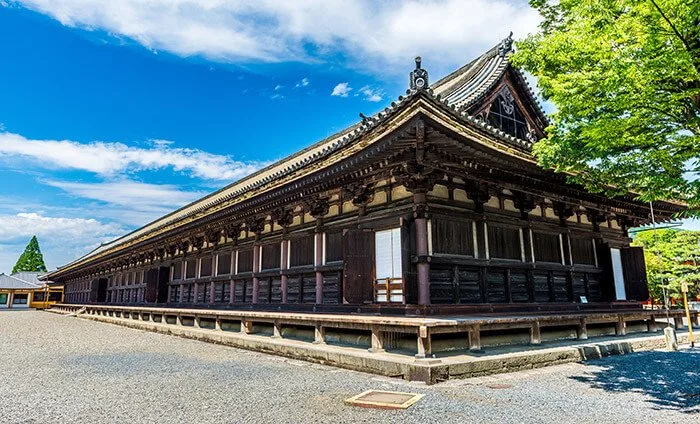
Sanjusangen-do Temple
While there are so many temples to visit in Kyoto, Japan, there are many things that make Sanjusangen-do special and well worth the visit.
Inside you will find 1,001 statues of the Buddhist goddess of compassion, Kannon. There are hundreds of other statues on the premises, as well.
The building itself is important as a piece of architecture. It dates back to 1164, although it was rebuilt in the 13th century after a fire.
At 120 meters, it is also the longest wooden building in Japan. Keep in mind that photos are prohibited, although this gives you a chance to truly take in the serene atmosphere.
Address: 657 Sanjusangendomawari, Higashiyama Ward, Kyoto, 605-0941, Japan
15. Kyoto International Manga Museum
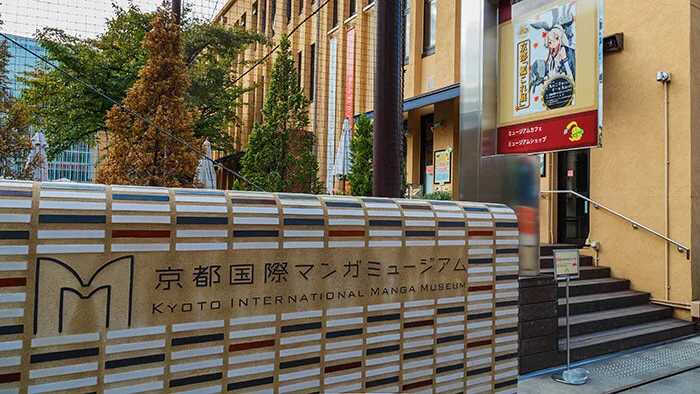
Kyoto International Manga Museum
If you’re interested in manga or just curious, the Kyoto International Manga Museum is a great destination.
This is the first museum in Japan dedicated to manga, or Japanese comic books and offers an extensive collection.
With three floors filled with books, this is a perfect way to spend an afternoon in Kyoto, especially with kids. If you don’t speak Japanese, you don’t have to miss out.
The museum also has a foreign language section and more works continue to be translated. Check before you visit to see if there are any special exhibitions.
Address: Karasuma-Oike, Nakagyo-ku, Kyoto 604-0846 Japan
16. Mayumura
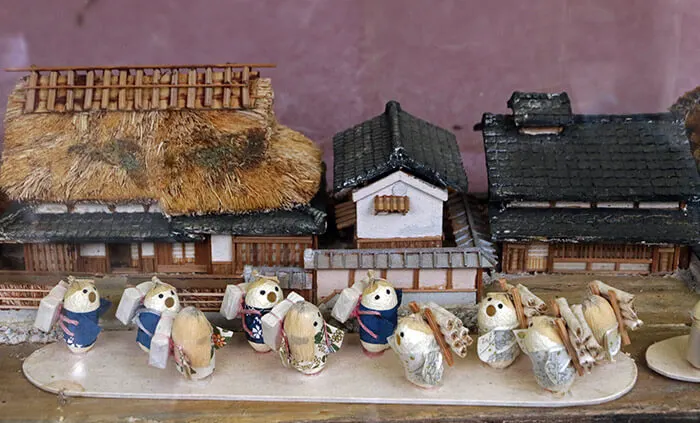
Mayumura
If you’re looking for a truly unique shopping experience, don’t leave Kyoto without visiting Mayumura. This unique souvenir-craft shop truly stands out in a city that is full of many.
Mayumura translates to “cocoon village,” and you’ll find a wide variety of objects made out of silkworm cocoons.
Customers are allowed to design their own creations to take home, which makes a unique souvenir of your trip to Kyoto, Japan.
Address: Sagatoriimoto Adashinocho, Ukyo Ward, Kyoto, 616-8436, Japan
17. Ikebana (Flower Arranging)
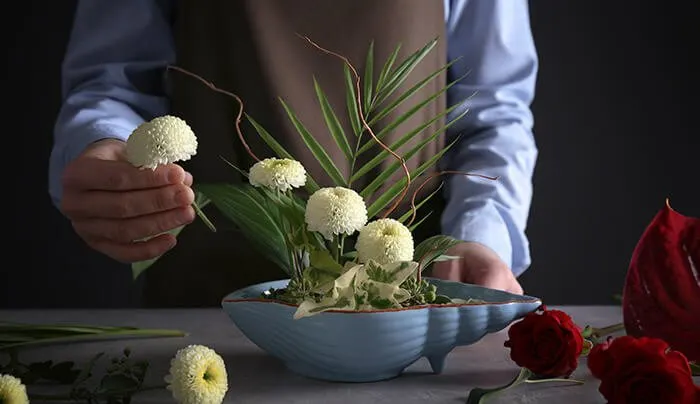
Ikebana (Flower Arranging)
If you’re traveling to Kyoto, Japan, don’t miss the opportunity to experience something new.
Ikebana is the art of flower arranging and is something highly unique to Japanese culture. This practice has been passed down the generations for over 500 years.
Like many other traditional Japanese practices, it is not simply about the flower arrangement and expression that it offers, but has a philosophical element as well.
In addition to flowers, trees and grasses are also used.
While flower arrangement also exists as a western art, in Japanese Ikebana, simplicity is incredibly important. Every object is placed in its space with a very deliberate intention.
Kyoto actually has an entire museum dedicated to Ikebana for those who are interested in learning more.
Address (Ikebana museum): 595 Manjuyacho, Nakagyo Ward, Kyoto, 604-8161, Japan
18. Kyoto National Museum
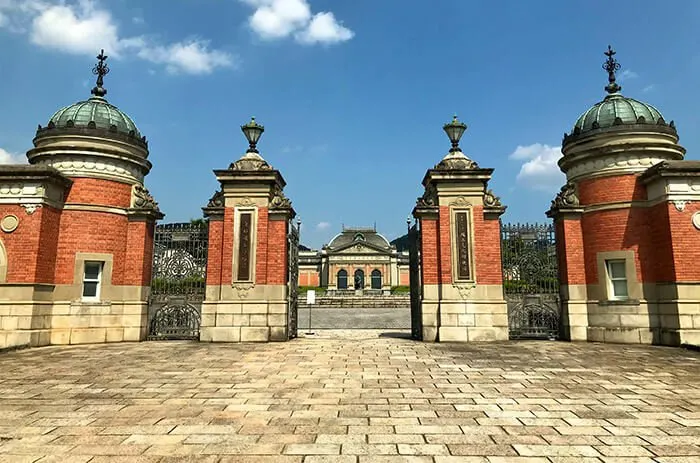
Kyoto National Museum
The Kyoto National Museum opened in 1897 and is one of the oldest museums in Japan.
Its permanent collection includes exhibits related to a wide variety of subjects, including paintings, sculpture, archaeology, calligraphy, and more.
In addition to the treasures housed within, the museum itself is of great architectural significance.
The original brick structure was constructed in 1895 during the Meiji Period and is one of the best examples of Meiji architecture in Kyoto.
This is now where special exhibits are housed. The permanent collection is housed in a newer building which opened in 2014, designed by well-known architect Taniguchi Yoshio.
Address: 527 Chayacho, Higashiyama Ward, Kyoto, 605-0931, Japan
19. Higashi Hongan-ji Temple
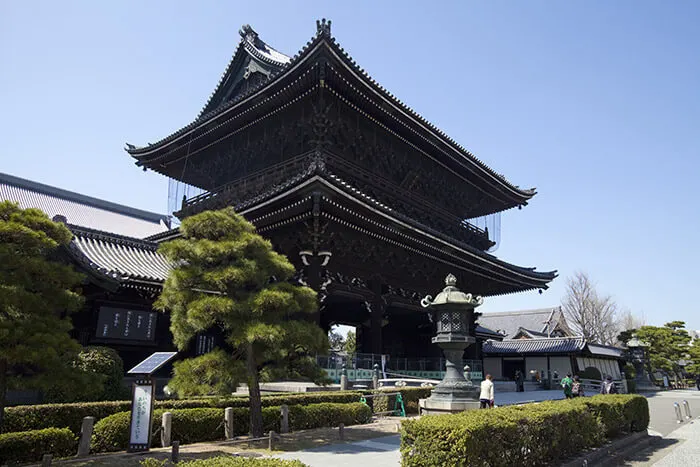
Higashi Hongan-ji Temple
Higashi Hongan-ji is also known as the Eastern Temple of the Original Vow. This Shin Buddist temple is a ten-minute walk from Kyoto Station.
This complex was originally built in 1604, but was destroyed by fire four times before it was reconstructed in the late 19th to early 20th century.
The Founder’s Hall is the largest wooden building in Kyoto, and among the largest anywhere in the world.
One of the oddities that make this destination unmissable is the fact that you’ll find what appears to be an enormous coil of ordinary rope but is actually completely made of real human hair.
Nuns offered their hair to be turned into rope to be used to haul the beams into place during the reconstruction.
If you’re visiting Kyoto on a budget, keep in mind that entrance is free!
Address: Karasuma Shichi-jō Agaru, Shimogyō-ku, Kyoto 600-8505, Japan
20. Local Tour Guides
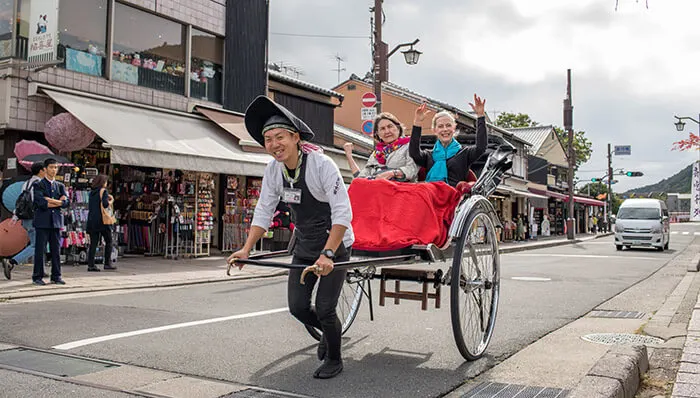
Local Tour Guides
Although Kyoto is an amazing city to explore on your own, why not explore on a walking tour guided by a local?
This way you can enjoy a highly personalized experience, and you will likely discover a lot of hidden gems along the way that most tourists wouldn’t see.
A local tour guide can make recommendations for eating and entertainment around the city tailored to what you’re looking for.
If you’re traveling to Kyoto on your own and looking to make more connections with local residents, this is a great way to get started and have an authentic experience.
21. Gion District
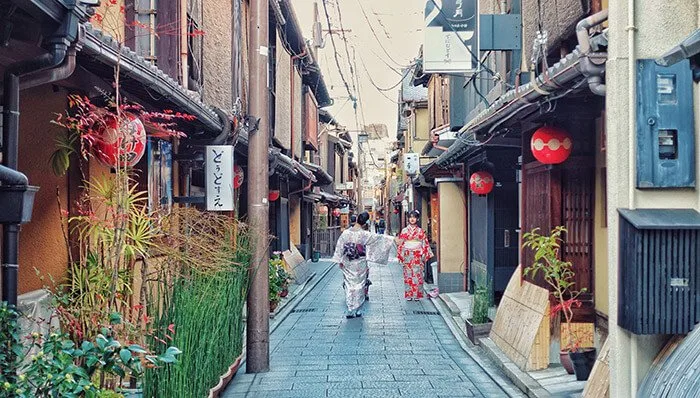
Gion District
If you’re looking to experience a taste of traditional old-world Japan, don’t hesitate to visit the Gion district in Kyoto.
This area used to be where pilgrims stopped along the way to visit the Gion Shrine, now called the Yasaka Shrine.
Now it is considered one of the most beautiful historic areas to visit in all of Kyoto. This area is also known as the Geisha district.
At Hanami Lane, you’ll find some amazing examples of traditional Japanese architecture. You will also find numerous teahouses in the area.
Ichiriki Ochaya is over three hundred years old and among the most famous and is a short walk from Yasaka Shrine.
For the best experience take a guided tour of Kyoto at night and don’t forget to take some pictures!
Address: 21-2 Tsukimicho, Higashiyama Ward, Kyoto, 605-0829, Japan
22. Gion Tatsumi Bridge
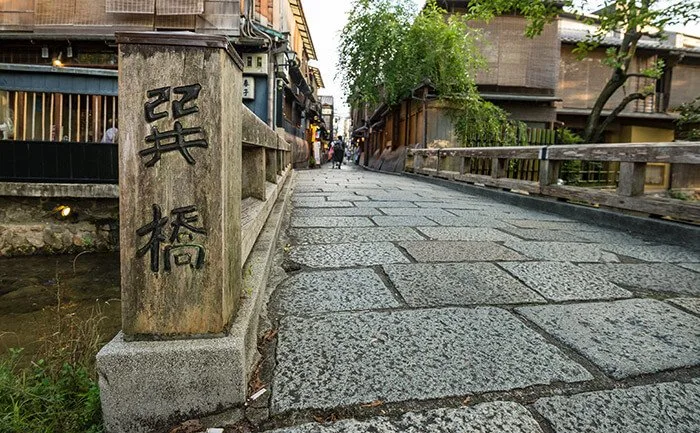
Gion Tatsumi Bridge
This beautiful stone bridge is one of the most popular attractions in Kyoto’s Gion district.
With great views of the river, the bridge is a great spot for taking photographs and is a great place to see some of Kyoto’s cherry blossoms.
The fact that it is still representative of the old traditional style of the city means it is also a great place to pose with a kimono for an unforgettable photo op.
While it’s a short bridge, it’s an essential stop on any walking tour of the city.
You’ll find a variety of teahouses nearby, making it the perfect way to end a day of sightseeing around beautiful Kyoto.
23. Yasaka Pagoda And Higashiyama District
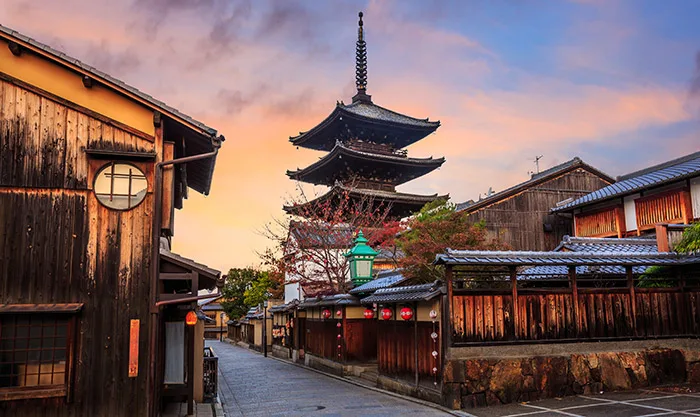
Yasaka Pagoda And Higashiyama District
Located in the Higashiyama district, Yasaka Pagoda is one of the most photographed landmarks in Kyoto, Japan.
This is a historic district located close to the Gion district, which means it can easily fit into your itinerary.
The district is full of winding streets, traditional architecture, and shops, meaning it is perfect for exploration.
One of Kyoto’s most photographed landmarks, Yasaka Pagoda truly stands out. Built in 592, this is the oldest pagoda to be found in Kyoto.
Continue 10 minutes north to visit Yasaka Shrine, built in 656.
Address: 388 Yasakakamimachi, Higashiyama Ward, Kyoto, 605-0862, Japan
24. Kembu Demonstration
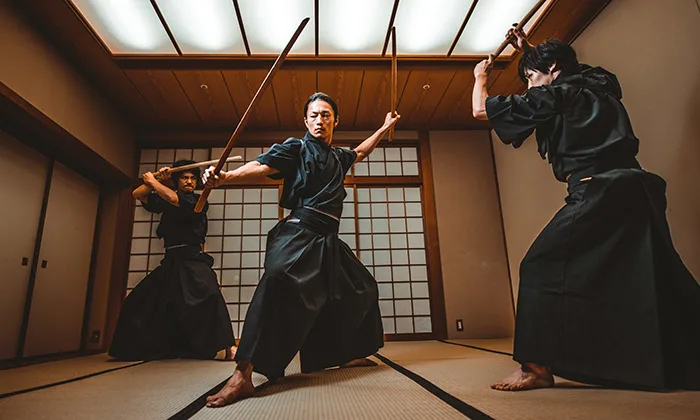
Kembu Demonstration
If you’re visiting Kyoto, Japan and want to really take in traditional Japanese culture, you should put checking out a Kembu demonstration high on your list.
Kembu is a martial art that involves swordplay mixed with dancing.
The Samurai Kembu Theater, located right in the city center, is the perfect place to experience this unique art form.
This is a small theatre, which means it is the perfect chance to get up close to the action.
In addition to watching the show and hearing old Samurai stories, you can also take lessons and become part of the Samurai world yourself.
Address: 35-7 Sanchome, Higashiyama-ku | B1F GOZAN Bldg., Kyoto 605-0005, Japan
25. Yokai Street
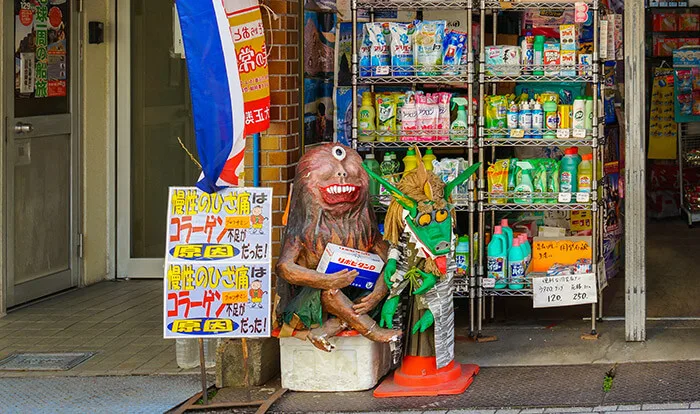
Yokai Street
Kyoto’s Ichijo-dori may seem like a normal street full of shops at first glance, but this street is actually full of homemade Yokai.
Yokai are traditional Japanese monsters, ghosts, and demons that come in a wide variety of forms.
The Yokai were said to have sprung to life after a yearly ritual known as Susuharai, household items that are broken or unused are discarded.
According to the legend, 100 of these objects were unhappy about their fate and marched along this very street until some Buddhist priests intervened.
The legend is now celebrated with homemade Yokai “haunting” the outsides of the shops.
This isn’t a normal tourist attraction but makes for a fun photo op. Walking around and trying to spot all the homemade Yokai is a fun activity for children and adults alike.
Address: 24 Nishimachi, Kamigyo-ku | Yokai Soho, Kyoto 602-8371, Japan
26. The Path Of Philosophy
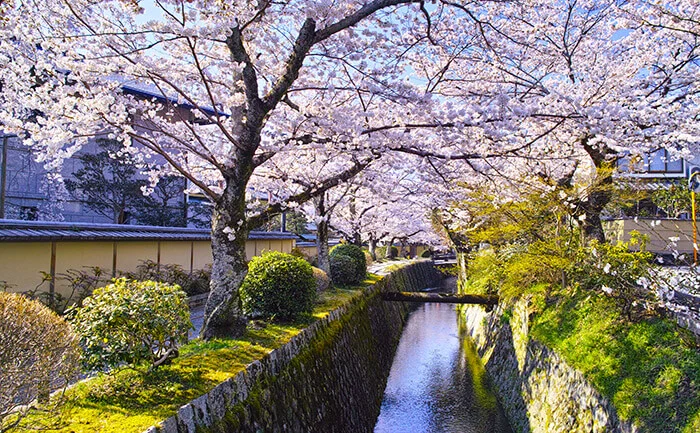
The Path Of Philosophy
In the Northern part of Kyoto’s Higashiyama district, you will come across the Path of Philosophy. Following the canal, hundreds of cherry trees line this serene stone path.
One of Japan’s most well-known philosophers, Nishida Kitaro, used to follow this path during his daily commute and meditate, which is where the name comes from.
Follow this path yourself and contemplate the meaning of life or simply take in the natural wonder.
This is a popular spot in April when the cherry blossoms bloom.
The path runs between Ginkakuji and NanZenji, and takes approximately 30 minutes, although you may find yourself stopping frequently along the way to simply take it all in.
Address: Shishigatani Honenin Nishimachi, Sakyo Ward, Kyoto, 606-8427, Japan
27. Rent A Kimono
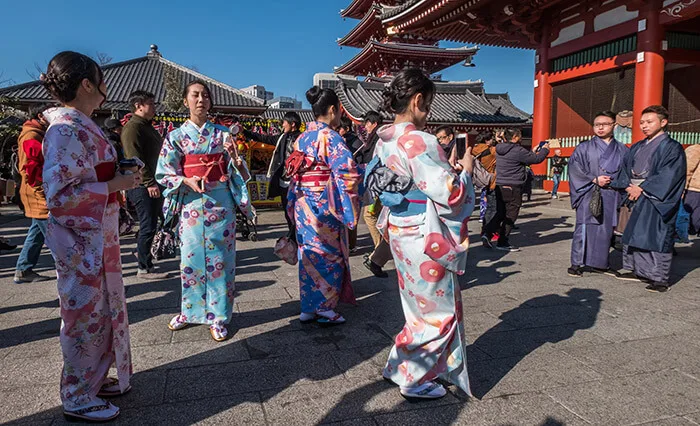
Rent A Kimono
If you’re in Kyoto, why not take learning about traditional Japanese culture to the next level? You can rent a kimono for the day and wander around Kyoto’s historic districts.
The kimono as we know it came about sometime between 794-1192 during the Heian period, and is one of the most iconic symbols of traditional culture in Japan.
Outfit yourself with the perfect Kimono, complete with Japanese sandals and obi bel.
28. Yasui Konpiragu Shrine
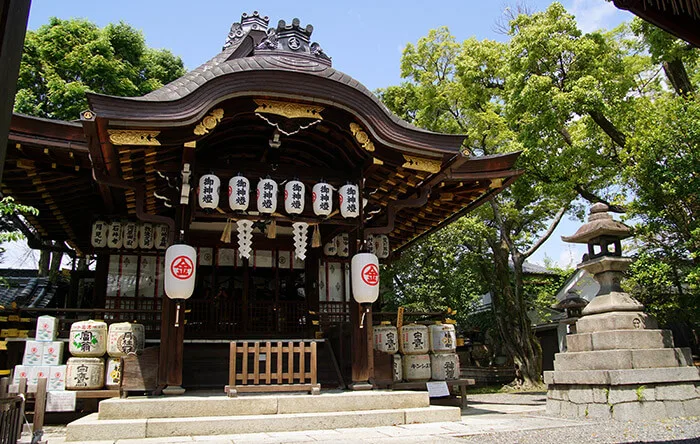
Yasui Konpiragu Shrine
While you will come across many shrines in Kyoto, Japan, none of them are quite like Yasui-kompira-gu Shrine.
The history of the shrine begins during the reign of the 38th Emperor Tenchi (668 to 671 C.E.) when it was created as a place to pray for prosperity.
However, this isn’t what it is most famous for. A huge stone with a hole in the middle is located on the shrine grounds, and you’ll see that it’s covered in white papers.
The story goes that one ties a slip of paper to the stone on which is written a wish related to your love life, and then crawls through the hole.
Whether you’re a romantic or not, don’t miss the chance to take part in a ritual unique to the city of Kyoto.
Address: 70 Shimobentencho, Higashiyama-ku Kyoto-shi, Kyoto, 605-0823, Japan
29. Chion-in Temple
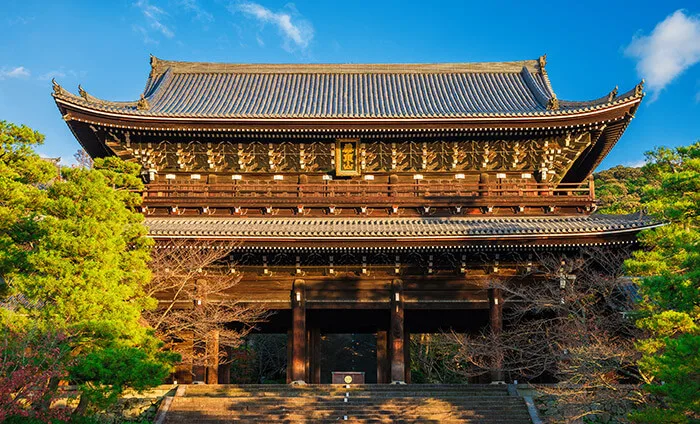
Chion-in Temple
While in Kyoto, check out Chion-in, one of the city’s largest temples.
This is the head temple of the Jodo sect of Buddhism, which is one of the most popular in Japan with millions of followers.
It was originally constructed in 1234, although it burned down in the 1600s. One of the temples most striking features is the absolutely massive Sanmon Gate.
Located along the road between Shorenin Temple and Maruyama Park, this gate is 50 meters wide and 24 meters tall.
This is the largest wooden gate not only in Kyoto, but in all of Japan.
Address: 400 Rinkacho, Higashiyama Ward, Kyoto, 605-8686, Japan
30. Nishiki Market
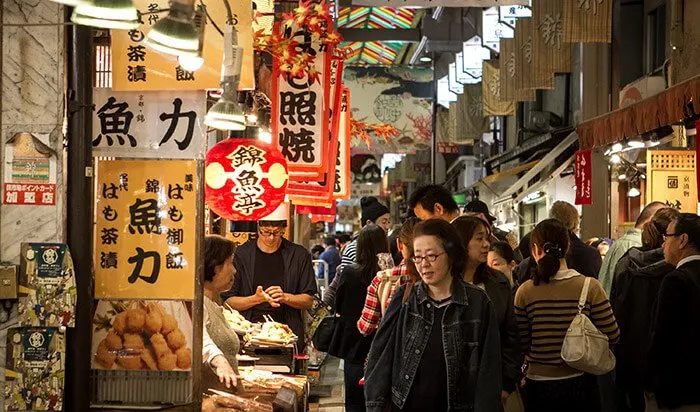
Nishiki Market
If you’re looking to purchase some of Kyoto’s one of a kind delicacies after a long day of sightseeing, visit Nishiki Market.
Also known as the ‘kitchen of Kyoto,” this market is more than 700 years old.
It began as a fish market in 1310. Here you’ll discover a wide variety of food items, including sushi and fresh seafood.
Many of the shops you’ll find here have been owned by the same family for centuries, and you will get a sense of history and atmosphere while sampling a host of culinary delights.
You can even purchase cookware and specialty knives as souvenirs of your trip to Kyoto!
Address: 609 Nishidaimonjicho Tominokoji Dori Shijoagaru, Nakagyo, Kyoto 604-8054, Japan
31. Mimizuka
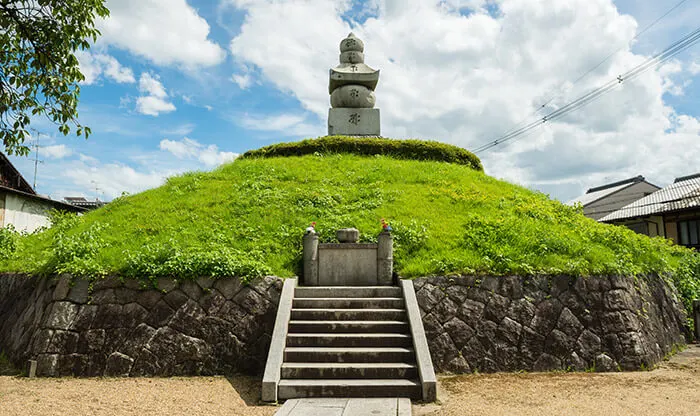
Mimizuka
One of the more grisly tourist destinations in Kyoto, Japan, this monument is dedicated to the Korean soldiers and Ming Chinese troops that were killed during the Japanese invasions of Korea from 1592 to 1598.
The name translates to “Mound of Ears,” referring to the fact that ears and noses were taken back as war trophies during this time.
At Mimizuka, it’s estimated that as many as 100-200,000 noses are buried at this site.
The monument was unknown even to many residents of Japan and was not even mentioned in Japanese textbooks until the mid-1980s.
Although it has been the subject of much controversy and there was even an attempt to level it in the 1970s, it now stands as a site to honor the deceased while reminding those who visit Kyoto of the brutal savagery of the past.
Address: 533-1 Chayacho, Higashiyama Ward, Kyoto, 605-0931, Japan
Start Planning Your Trip To Kyoto
While you will find many pictures of Kyoto, Japan, nothing truly compares to standing in front of these magnificent structures and walking through its historic districts on your own.
If Japanese culture is something you find interesting, there’s no reason not to start planning your trip to Kyoto, Japan today!
